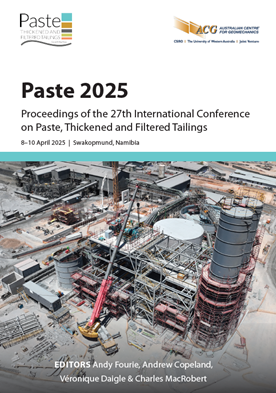Stacking angles for dewatered coarse diamond residues

|
Authors: MacRobert, C; Ntloyakhumo, W; Gabanakgosi, L; Dambe, N; Bohule, B; Moganetsi, A |
DOI https://doi.org/10.36487/ACG_repo/2555_03
Cite As:
MacRobert, C, Ntloyakhumo, W, Gabanakgosi, L, Dambe, N, Bohule, B & Moganetsi, A 2025, 'Stacking angles for dewatered coarse diamond residues', in AB Fourie, A Copeland, V Daigle & C MacRobert (eds), Paste 2025: Proceedings of the 27th International Conference on Paste, Thickened and Filtered Tailings, Australian Centre for Geomechanics, Perth, pp. 65-74, https://doi.org/10.36487/ACG_repo/2555_03
Abstract:
Diamond processing results in three residue streams, commonly termed fine residue (clay–silt sized), grits (silt–sand sized) and tails (sand–gravel sized). Dewatering of the tails is typically done using screens and metallurgical moisture contents of 5–11% can often be achieved. Grits are often dewatered using dewatering screens and metallurgical moisture contents of between 17–25% can be achieved. These dewatered streams can therefore be disposed of using dry material handling techniques (e.g. conveyors, trucks and dozers). Fullscale dewatering of fines is yet to be demonstrated and disposal to tailings dams by either conventional slurry, thickened tailings or paste is common. A key design decision, particularly if co-disposal of tails and grits is under consideration, is the short-term (months) stacking angle and how this may change in the long term (years). A benchmarking exercise of several operations was undertaken to understand stacking angles. This found that grits content (which controls metallurgical moisture content), mineralogy and process water salinity were major determinants of behaviour. High smectite ores processed with low-salinity waters tended to produce flat stacking angles (≈ 8°), whereas all ores, regardless of smectite content but processed with highly saline waters, tended to produce steeper stacking angles (≈ 18 to 34°). Low-saline waters cause the smectites to swell and disperse, resulting in a mass that has a greater propensity for lava-like flow as water is held by the solids on disposal. In contrast, the highly saline waters inhibit this swelling (if smectite is present), resulting in a free-draining material which stacks steeply on disposal. However, over the long term, smectites can still swell in the presence of water, causing weathering. If sufficient free water (e.g. through codisposal) is available, moisture can accumulate and create weak layers within the deposit, altering the stacking angle.
Keywords: dry disposal, stacking angles, mineralogy, metallurgical moisture content, grading
References:
Blight, G 2003, ‘Quantified comparisons of disposal of thickened and unthickened tailings’, Tailings and Mine Waste ‘03: Proceedings of the 10th International Conference, Swets & Zeitlinger, Lisse, pp. 63–71.
Copeland, AM, Lyell, AM & van Greunen, P 2006, ‘Disposal of belt filtered tailings – skorpion zinc case study: feasibility, design and early operation’, in RJ Jewell, S Lawson & P Newman (eds), Paste 2006: Proceedings of the Ninth International Seminar on Paste and Thickened Tailings, Australian Centre for Geomechanics, Perth, pp. 243–254,
Davies, M 2011, ‘Filtered dry stacked tailings – the fundamentals’, Tailings and Mine Waste '11: Proceedings of the tailing and mine waste conference, University of British Columbia, Vancouver.
Nelson, JD 1995, ‘Tailings, tailing or tails’, Tailings and Mine Waste '96: Proceedings of the Third International Conference on Tailings and Mine Waste, Taylor & Francis, New York, pp. 3–6.
Vargas, CC & Campomanes, GP 2022, ‘Practical experience of filtered tailings technology in Chile and Peru: an environmentally friendly solution’, Minerals, vol. 12, no. 7,
Wates, J 1983, ‘The disposal of mine tailings: the real cost of excess water in residues’, Journal of the Southern African Institute of Mining and Metallurgy, vol. 83, no. 11–12, pp. 257–262.
© Copyright 2025, Australian Centre for Geomechanics (ACG), The University of Western Australia. All rights reserved.
View copyright/legal information
Please direct any queries or error reports to repository-acg@uwa.edu.au
View copyright/legal information
Please direct any queries or error reports to repository-acg@uwa.edu.au
